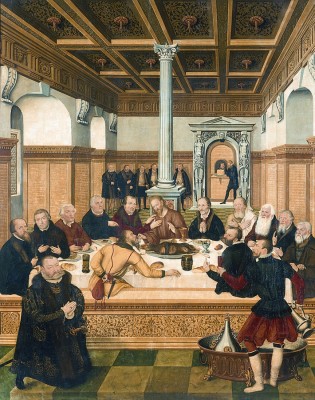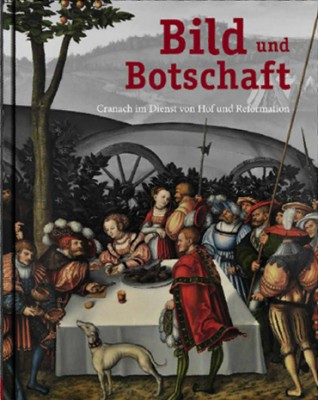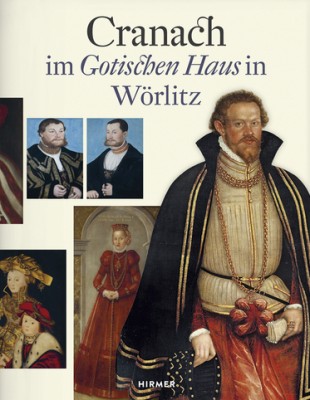Cranach the Younger was in his own right a remarkable painter of the reformation. This year a series of exhibitions throws a spotlight on his work.
Cranach the Elder is known as the artist, who through his friendship with Luther turned into the “visualizer” of the reformation. His son, Cranach the Younger, was also a painter. Born in 1515 in Wittenberg he continued the work of his father.
In memory of his birth in 1515 one of the major exhibitions in Germany (one of the so-called “Landes-ausstellungen”) will be mounted by Sachsen-Anhalt and Thüringen next summer.
It is the first worldwide exhibition, which dedicates itself to the life and work of this painter. The exhibition will open at 7 different original locations: Lutherstadt Wittenberg, Dessau, Wörlitz, Eisenach, Gotha, Weimar and Erfurt. Other places may also be included in the itinerary.
Wittenberg

In Wittenberg the exhibition tells the story of the life and work of Lucas Cranach the Younger. It presents him as a facet-rich personality: as prudent head of the family, as city treasurer, intelligent mayor and an energetic entrepreneur. Above all, however, it presents the artist Lucas Cranach as a royal contractor, as painter of reformatory altars and epitaphs, as an excellent portraitist and a highly talented draughtsman. In the years of the confessional conflicts after Luther’s death he made an important contribution for the propagation of the new faith. His societal portraits show how calculated he knew to utilize his pictorial possibilities. Up to his death in 1586 Lucas Cranach the Younger led one of the largest and most productive work of art studios of Europe in Wittenberg. He was a skillful artist who understood his craft and acted in the midst of a large personal and vocational network. Great works of art from German and international collections as well as exciting medial representations convey these connections. They enable the long time overdue discovery of Cranach the Younger as a widely unknown master from Wittenberg. The exhibition is to be seen at the Augusteum, the front building of the Lutherhaus.
Cranach’s Church and the Reformation Altar
Another venue in Wittenberg is the church of St. Mary, which holds numerous original paintings of Lucas Cranach the younger. For the exhibition in “Cranach’s Church”, Cranach’s works of the Town Church St. Marien are extravagantly restored, first of all the well-known Reformation Altar, on which Lucas Cranach the Younger together with his father worked. Further important works are the epitaphs for Johannes Bugenhagen and Paul Eber, the latter better known by his title “Der Weinberg des Herrn” (“The vineyard of the Lord”). The works are considered as particularly important testimony of Reformation history. Additional elucidations and texts complete the exhibition. The Cranach Altar in the church of St. Mary in Wittenberg has recently been restored. The result will be unveiled in Wittenberg on the 31st of October.
Cranach in Anhalt
The city of Dessau was closely connected with the reformation and the Cranach family often visited the town, which lies 35 km. from Wittenberg
With the impressive epitaphs in the Church of St. John, with the famous Dessauer “Fürstenaltar“ (“Princes’ Altar”) and other major works of Cranach the Elder as well as other masterpieces of old German painting and graphics from the Anhalt Art Gallery in Dessau, the exhibition draws a multifaceted image of the background for the art of the younger Cranach.
Cranach in the Gothic House in Wörlitz
Prince Franz of Anhalt-Dessau (1751 – 1817) was an avid collector of the work of both Cranach the Elder and Younger. All in all he acquired 20 works, which will be displayed in accordance with the original hanging scheme.
The Luther Portraits of the Cranach Workshop at Wartburg

Between 1520 and 1546 seven different graphic and painted portrait models of Martin Luther developed in the workshop of Cranach the Elder and Younger.
All these portraits served as both propaganda and documentary and were deliberately used for didactic purposes. The portrait of Luther thereby assumed a substantial function as ambassador for the reformatory program and a complete illustration of his biographical background.
The exhibition presents this typology but is also concerned with the organization of the Wittenberg workshop. Painted and graphic portraits of the monk and reformer were focal points, which were supplemented by portraits of other contemporaries. The exhibition aims to show that the Luther portrait has remained current in contemporary art up to today.
Cranach in Weimar
The focus of the Cranach exhibition in Weimar are the particular rich collection of paintings, designs, prints, graphics, book art and much as well as the unique winged altar in in the church St. Peter and Paul (Herderkirche). Completed in 1555 it represents one of major works of reformatory art. The exhibition especially explores this altar donated to the memory of Johann Friedrich the Magnanimous and Sibylle von Cleve and other works from the Cranach workshop created for the Ernestinian court.
Cranach in the service of the Court and the Reformation in Gotha

Within the decade of Luther the 500th Birthday of Lucas Cranach the Younger provides the opportunity to delve into the early modern period and the beginning of the Reformation. Emphasis of the prodigious special exhibition in the Herzoglichen Museum (Ducal Museum Gotha) will be the official character of the Cranach workshop in the service of the Elector of Saxony and the Reformation. The exhibition explores how political messages of the Ernestinian dynasty and the teachings of Luther were illustrated. The extremely productive Cranach workshop developed new image concepts. By means of top-notch works from international collections the productivity and innovative strength of Cranach family will be demonstrated. An exciting look at an early form of “picture propaganda” that allows a new view of old German painting.
Controversy and Compromise in Erfurt
The museum in Erfurt highlights the pictures in the Erfurter Cathedral, which originated in 1506. In Erfurt a unique dual-confessional culture developed between town councillors and the prince bishop. This lead to a dispute carried out not only through to word and scripture, but also through “images”. The exhibition explores the theological, liturgical and culturally historical background and places them in the context of the emerging reformation.
VISIT:
Lucas Cranach the Younger – Discovery of a Master
Wittenberg 26.06.2015 – 01.11.2015
Lucas Cranach and the Old German Painters
Johannbau in Dessau-Rosslau, 26.06.2015 – 01.11.2015
Cranach in the Gothic House in Wörlitz
Wörlitz, 16.05.2015 – 04.10.2014
The Luther Portraits of the Cranach Workshop
Wartburg 02.04.2015 – 19.07.2015
Controversy and Compromise
Angermuseum Erfurt 16.05.2015 – 23.08.2015
Cranach in the service of the Court and the Reformation
Gotha 20.03.2015 – 19.07.2015
Cranach in Weimar
Schiller Museum 03.04.2015 – 14.06.2015
SEE MORE:
In connection with the focus on Cranach twelve German cities have come together to develop a Cranach-Route: Kronach, Coburg, Nuremberg, Lutherstadt Wittenberg, Dessau-Rosslau, Meissen, Neustadt and der Orla, Gotha, Erfurt, Schneeberg, Eisenach, Weimar.
In connection with the route a booklet has been made available:
In the Footsteps of Cranach. A Journey of Discovery.
READ MORE:
Serpent and the Lamb. Cranach, Luther and the Making of the reformation
By Stephen Ozment
Yale University press 2011
The Cranach Digital Archive (cda) is an interdisciplinary collaborative research resource, providing access to art historical, technical and conservation information on paintings by Lucas Cranach (c.1472 – 1553), his sons and his workshop. The repository presently provides information on more than 1,100 paintings including c. 10,400 images and 790 pdf documents from 146 contributing institutions as well as 150 digitized and transcribed archival documents and 2,750 literature references.
Started in 2009 the project is in its second phase (2012 – 2014). In this period the CDA aims to expand the existing network, to develop the shared infrastructure and to increase its content in order to build the foundations for an innovative, comprehensive and collaboratively produced repository of knowledge about Lucas Cranach and his workshop that will be significantly different from the traditional model of the single-author catalogue raisonné.
The Cranach Digital Archive is a joint initiative of the Stiftung Museum Kunstpalast, Düsseldorf and Cologne Institute of Conservation Sciences / Cologne University of Applied Sciences in collaboration with nine founding partner institutions, 19 associate partners and many project contributors. The project is funded by the Andrew W. Mellon Foundation.
Cranach.net is the interdisciplinary research-wiki, which functions as a virtual Cranach Institute. The aim is to further research into the work of Lucas Crananch the Elder, his sons and their workshops. Another project is directed towards developing a comprehensive catalogue of their works (Corpus Cranachs).
Catalogues and Books published in connection with the Crananch-Jahr
 Bild und Botschaft: Cranach im Dienst von Hof und Reformation
Bild und Botschaft: Cranach im Dienst von Hof und Reformation
By Stiftung Schloss Friedenstein Gotha
Morio 2015
ISBN-10: 3945424097
ISBN-13: 978-3945424094
Lucas Cranach the Elderer belongs among the most important German artists of the Renaissance. Hundreds of works bear witness to the many topics, which were touched upon by Cranach and his workshop For more than five decades the painter was in the service of the powerful Electors of Saxony, for which he decisively visualized the Protestant ideas. This richly illustrated catalogue explores the question of how Cranach came to characterize the triumph of the Reformation in such a decisive manner. The catalogue presents more than 100 major works from international collections. It also presents numerous essays from internationally renowned Cranach-experts.The catalogue is published on the occasion of the exhibitions mounted by the Foundation Schloss Friedenstein Gotha and the Museums in Hessen Kassel in the Cranach-year 2015.
 Lucas Cranach der Jüngere: Und die Reformation der Bilder
Lucas Cranach der Jüngere: Und die Reformation der Bilder
By Anne Eusterschulte, Gunnar Heydenreich and Elke A. Werner (Eds.)
Hirmer 2015
ISBN-10: 3777423688
ISBN-13: 978-3777423685
To celebrate the 500th birthday of Lucas cranach the Youngerer , international experts gathered at a symposium in order to trace a comprehensive as nuanced picture of the life and work of the artist . This book documents the results and opens up for new perspectives on the innovative artist, businessman and politician, who with great insight responded through his portraits, profane histories and religious themes to the profound changes of his time.
 Lucas Cranach: Im Gotischen Haus in Wörlitz
Lucas Cranach: Im Gotischen Haus in Wörlitz
By Kulturstiftung Dessau Wörlitz and ed. Dr. Wolfgang Savelsberg
Hirmer 2015
ISBN-10: 377742398X
ISBN-13: 978-3777423982
Leopold III, prince of Anhalt – Dessau (1740 – 1817) collected almost 600 old master paintings, called the Gothic house collection. This collection was hung in the Gothic House in the Wörlitzer Park.The core was one of the first Cranch collections in the world. This collection has been carefully reconstructed and hung in its original surroundings. This volume contains articles by art historians, who provides an insight into the reception of the paintings and their dynastic and religious significance, which is stressed by the original context.
 Cranach, Luther und die Bildnisse: Thüringer Themenjahr “Bild und Botschaft”
Cranach, Luther und die Bildnisse: Thüringer Themenjahr “Bild und Botschaft”
By Günter Schuchardt and Grit Jacobs
Schnell & Steiner 2015
ISBN-10: 3795429773
ISBN-13: 978-3795429775
In 1520 the Wittenberg Cranach workshop created 46 portraits of Martin Luther. The volume presents the different portraits and how the workshop organized itself in order to take on this job. The book focuses on portraits of the reformer and how they came to visualize the reformer for centuries to come. In the 1520s radical movements led to widespread iconoclasm directed against idolatry and the practice of the veneration of saints. Martin Luther, however, did not rejected images but found them useful, when they contributed to the understanding of the texts and his teachings. His own portrait served to enforce the Reformation as an instrument of propaganda and documentary image and didactic purposes. The portraits of Luther took over as ambassador of the reformatory program and illustration of his biographical career an essential function. The book appears as a contribution to the Cranach-year 2015
